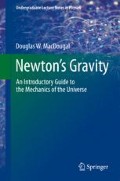Abstract
Toward the end of his classic book, Interplanetary Flight, Arthur C. Clarke in 1950 was looking ahead to the end of the twentieth century and the prospects for the future of space travel. He noted that to the ordinary man “this planet is still the whole of the universe: he knows that other worlds exist, but the knowledge does not affect his life and therefore has little real meaning to him.” But this, Clarke predicted, would soon be a thing of the past:
Access this chapter
Tax calculation will be finalised at checkout
Purchases are for personal use only
Notes
- 1.
Arthur C. Clarke [1].
- 2.
Ibid., 145.
- 3.
Ibid.
- 4.
Ibid, xiii.
- 5.
Ibid.
- 6.
From the NASA/JPL website, http://ssd.jpl.nasa.gov/txt/p_elem_t1.txt.
- 7.
See Chap. 12’s discussion on the Gaussian constant for the derivation of this number.
- 8.
This summary was drawn from NASA’s excellent resource, http://history.nasa.gov/SP-4029/Apollo_11a_Summary.htm.
- 9.
One nautical mile, the unit used by NASA, is 1.852 km. See http://en.wikipedia.org/wiki/Nautical_mile. Using this measure, NASA used a value for the Earth’s radius of 6,378.159656 km.
- 10.
See http://history.nasa.gov/SP-4029/Apollo_18-21_Earth_Orbit_Data.htm for the parameters of the Earth orbits for the Apollo spacecraft.
- 11.
See http://history.nasa.gov/SP-4029/Apollo_18-24_Translunar_Injection.htmv for a comprehensive summary of the launch and injection parameters of all the spacecraft in the Apollo program.
- 12.
Robert A. Braeunig has calculated the velocities at each point in the mission at http://www.braeunig.us/apollo/apollo11-TLI.htm.
- 13.
NASA’s value for the radius of the Earth (converted from nautical miles) is 6,378.159656 km, which we use for this discussion. The value of μ is slightly more refined here: GM = 3.9857×1014, which is a slightly more precise value than the 3.99 × 1014 value used for most of the problems. This is found by the product of the mass of the Earth of 5.97219 × 1024 kg, taken from the NASA site, http://ssd.jpl.nasa.gov/?planet_phys_par, and the CODATA value of the Newtonian Gravitational Constant of 6.67384 × 10−11 m3kg−1 s−2. See http://physics.nist.gov/cgi-bin/cuu/Value?bg|search_for=G. The result was then rounded to four decimal places.
- 14.
- 15.
This result was obtained using TheSky software.
- 16.
Arthur C. Clarke [1], p. 1.
Reference
Clarke AC (1950) Interplanetary flight. Harper & Row, New York
Author information
Authors and Affiliations
Rights and permissions
Copyright information
© 2012 Springer Science+Business Media New York
About this chapter
Cite this chapter
MacDougal, D.W. (2012). Introduction to Spaceflight. In: Newton's Gravity. Undergraduate Lecture Notes in Physics. Springer, New York, NY. https://doi.org/10.1007/978-1-4614-5444-1_14
Download citation
DOI: https://doi.org/10.1007/978-1-4614-5444-1_14
Published:
Publisher Name: Springer, New York, NY
Print ISBN: 978-1-4614-5443-4
Online ISBN: 978-1-4614-5444-1
eBook Packages: Physics and AstronomyPhysics and Astronomy (R0)

